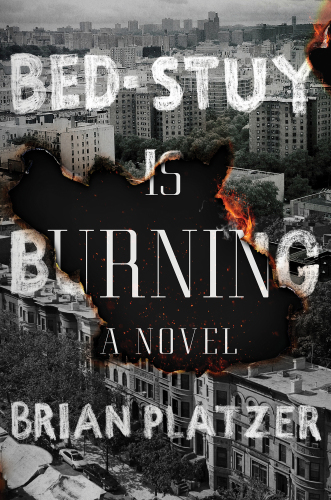
Bed-Stuy Is Burning
A Novel
- اطلاعات
- نقد و بررسی
- دیدگاه کاربران
نقد و بررسی

May 1, 2017
Platzer’s earnest and well-meaning, if superficial, debut novel centers on a single day of unrest in Brooklyn’s rapidly gentrifying Bedford-Stuyvestant neighborhood. Aaron, a former rabbi forced to abandon his synagogue in the wake of a loss of faith and (more critically) an ethical misstep, his girlfriend Amelia, and their infant son are among the vanguard of wealthy young white families moving into this historically black, architecturally rich neighborhood. Days after a police shooting of a preteen boy, racial tensions come to a head, and Aaron and Amelia find themselves and their historic brownstone in the crosshairs of their neighbors’ previously restrained resentments. The perspectives of secondary characters—including Aaron’s antisocial white tenant, their black nanny, the N.Y.C. police commissioner, and others—are ostensibly included to provide a diversity of voices. In reality, however, these multiple perspectives primarily serve to showcase the narrative’s lack of depth and failure to engage with social issues and urban complexity on anything more than a surface level. Perhaps readers largely unaware of discriminatory policing, economic injustice, or economic displacement will find the narrative enlightening, but those hoping for the novel to really grapple with these issues will be largely disappointed, as it descends into melodrama instead.

May 15, 2017
The city is burning indeed in New Yorker contributor Platzer's debut novel, sometimes with fire and sometimes with much-compounded shame.Aaron was once a rabbi, at least until he got caught with his hand in the synagogue's bank account, desperately trying to settle a gambling debt that involved organized crime, death threats, and suchlike mishegoss. Now, supposedly on the straight and narrow, though filled with epic doubts--"Belief had never been at the core of his rabbinical path," Platzer writes, though Aaron is fully certain of an inner rottenness that has kept God from stepping in on his behalf--he is the father of a baby son born to his girlfriend, Amelia, who writes service journalism pieces well below her capabilities. As the book opens, Aaron, now an investment banker, is contemplating just how fortunate he is to have found his way to this place--this place in life, that is, but also Bed-Stuy, in a beautiful home with nice neighbors. Others are not so lucky: a 12-year-old African-American boy is slain by a police officer in a nearby park, an event all too close to real life for so many citizens of Brooklyn and other cities. As protests and upheaval shake the streets, Amelia is called down for white privilege, Aaron gets caught up between cops and kids, and their carefully reconstructed life threatens to fall apart. Platzer is very good at doling out details of Aaron's tightly wound character and Amelia's reciprocal doubts, finding redemptions for both that, though not unlikely, do have a certain deus ex machina feel, given the distances each has to travel. In a story tinged with biblical allegory, Platzer also serves up some delicious set pieces for his supporting players. One of the best of them involves a young black woman recently escaped from arrest at an anti-police demonstration and wandering from store to store in the neighborhood trying to cash an improbably large check that she's come into. (And therein hangs a tale.) She can't, less because of the broken handcuffs trailing from her wrists than because she doesn't have proper ID. Notes a bemused clerk, "And they tell me gentrification isn't changing the neighborhood!" Expertly paced, eminently readable, and a promising start.
COPYRIGHT(2017) Kirkus Reviews, ALL RIGHTS RESERVED.

July 1, 2017
From the front lines of gentrification, income disparity, and racial tension in New York City comes this dramatic first novel that imagines a riot and its aftermath told by those involved on all sides. Aaron is a former rabbi and now successful Wall Street trader who owns a mansion in Bedford-Stuyvesant, Brooklyn, with Amelia, a writer, and their infant son. A neighborhood youth has recently been killed by police, tensions are escalating, and when more young people are arrested, a mob forms and targets the nicest houses that are owned by white outsiders, ending up at Aaron's place while he is not there. Several people are shot, and the mob is attacking the house as Amelia and Antoinette, their nanny, are locked inside, incommunicado. Multiple story threads converge as a standoff takes place on Aaron's front porch. VERDICT The author effectively creates a tense, realistic situation, and although some of the multiple narrators are occasionally long-winded, the prose is energetic, and Platzer is obviously committed to exploring these contemporary urban issues.--James Coan, SUNY at Oneonta Lib.
Copyright 2017 Library Journal, LLC Used with permission.

June 1, 2017
A gamble once cost Aaron his life as a rabbi, but without his penchant for risk taking, he wouldn't now be a successful financial manager and the new owner of a vintage brownstone on the most beautiful block in Bed-Stuy, Brooklyn. Platzer's debut takes place mostly over the course of a single day, on Rosh Hashanah, following a weekend when a 12-year-old, unarmed and black, was shot 10 times and killed by police. When Aaron heads to the subway on Monday morning, local teenagers are forcing their own arrests by jumping turnstiles in protest of the senseless killing. Demonstrations remain peaceable for only so long before violence threatens, cops react, and the angry crowd moves en masse, with Aaron and his girlfriend Amelia's brownstone, a symbol of the neighborhood's gentrification, as their first stop. Platzer, a writer and educator who lives in Bed-Stuy, is aiming high here, addressing race-related violence, the Black Lives Matter movement, gentrification, and other volatile topics. He succeeds in presenting multiple perspectives of dramatic yet familiar situations.(Reprinted with permission of Booklist, copyright 2017, American Library Association.)




دیدگاه کاربران